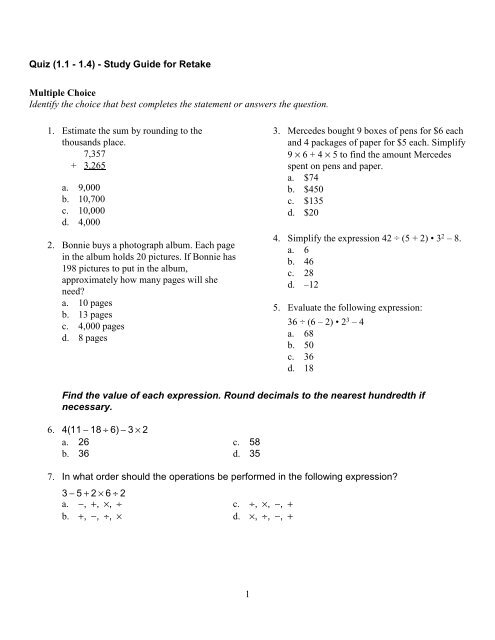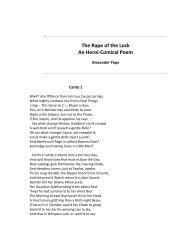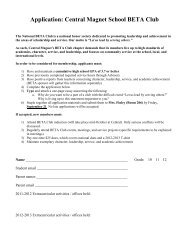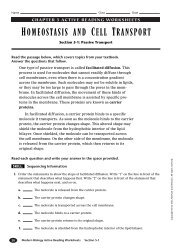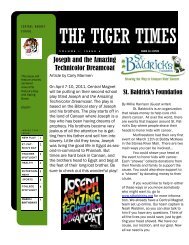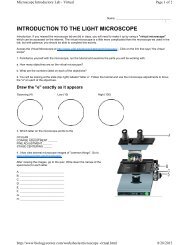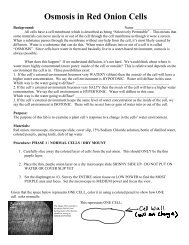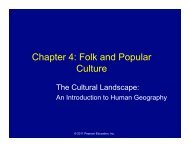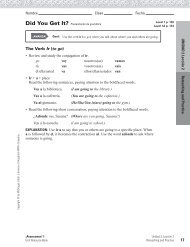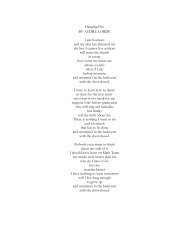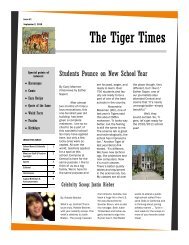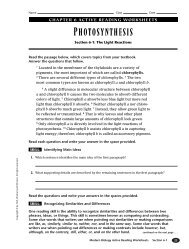Quiz - Lesson 1.1-1.4 (SG)
Quiz - Lesson 1.1-1.4 (SG)
Quiz - Lesson 1.1-1.4 (SG)
Create successful ePaper yourself
Turn your PDF publications into a flip-book with our unique Google optimized e-Paper software.
<strong>Quiz</strong> (<strong>1.1</strong> - <strong>1.4</strong>) - Study Guide for Retake<br />
Multiple Choice<br />
Identify the choice that best completes the statement or answers the question.<br />
1. Estimate the sum by rounding to the<br />
thousands place.<br />
7,357<br />
+ 3,265<br />
a. 9,000<br />
b. 10,700<br />
c. 10,000<br />
d. 4,000<br />
2. Bonnie buys a photograph album. Each page<br />
in the album holds 20 pictures. If Bonnie has<br />
198 pictures to put in the album,<br />
approximately how many pages will she<br />
need?<br />
a. 10 pages<br />
b. 13 pages<br />
c. 4,000 pages<br />
d. 8 pages<br />
1<br />
3. Mercedes bought 9 boxes of pens for $6 each<br />
and 4 packages of paper for $5 each. Simplify<br />
9 × 6 + 4 × 5 to find the amount Mercedes<br />
spent on pens and paper.<br />
a. $74<br />
b. $450<br />
c. $135<br />
d. $20<br />
4. Simplify the expression 42 ÷ (5 + 2) • 3 2 – 8.<br />
a. 6<br />
b. 46<br />
c. 28<br />
d. –12<br />
5. Evaluate the following expression:<br />
36 ÷ (6 – 2) • 2 3 – 4<br />
a. 68<br />
b. 50<br />
c. 36<br />
d. 18<br />
Find the value of each expression. Round decimals to the nearest hundredth if<br />
necessary.<br />
6. 4(11 − 18 ÷ 6) − 3 × 2<br />
a. 26 c. 58<br />
b. 36 d. 35<br />
7. In what order should the operations be performed in the following expression?<br />
3 − 5 + 2 × 6 ÷ 2<br />
a. −, +, ×, ÷ c. ÷, ×, −, +<br />
b. +, −, ÷, × d. ×, ÷, −, +
8. 46 – (3 + 1) ÷ 2<br />
a. 48<br />
b. 44<br />
c. 21<br />
d. 43.5<br />
9. Which equation represents the distributive<br />
property?<br />
a. 5(7 + 8) = (5 × 7) × (5 × 8)<br />
b. 5(7 + 8) = (5 + 7) × (5 + 8)<br />
c. 5(7 + 8) = (5 + 7) + (5 + 8)<br />
d. 5(7 + 8) = (5 × 7) + (5 × 8)<br />
10. Which equation best represents the commutative<br />
property?<br />
a. (x × y) × z = xz + yz<br />
b. (m × n) × p = m + (n × p)<br />
c. (b × c) × d = (c × b) × d<br />
d. (r × s) × t = (r × t) + (r × t)<br />
11. Hailey rewrote the expression (2 × 3) × 4 using<br />
the associative property. Which expression did<br />
she write?<br />
a. 4(2 + 3)<br />
b. 2 × 3 + 4<br />
c. 2 × (3 × 4)<br />
d. (2 + 3) + 4<br />
12. Which equation best represents the associative<br />
property?<br />
a. x + (y + 2) = (x + y)2<br />
b. x + (y + 2) = (x + x) + (y + 2)<br />
c. x + (y + 2) = xy + 2x<br />
d. x + (y + 2) = (x + y) + 2<br />
2<br />
13. Which statement represents the distributive<br />
property?<br />
a. 3(1.2 + 9) = (3 + 1.2) × (3 + 9)<br />
b. 3(1.2 + 9) = (3 × 1.2) + (3 × 9)<br />
c. 3(1.2 + 9) = (3 + 1.2) + (3 + 9)<br />
d. 3(1.2 + 9) = (3 × 1.2) × (3 × 9)<br />
14. Which sentence best represents the commutative<br />
property?<br />
a. 14 × 9 × 5 = 14 × 5 × 9<br />
b. 14 × 9 + 5 = 14 + 9 × 5<br />
c. 14 + 9 + 5 = 14 × (9 + 5)<br />
d. 14 + 9 × 5 = (14 + 9) × 5<br />
15. Which expression is equivalent to the expression<br />
below?<br />
5(a + 9)<br />
a. 14a<br />
b. 50a<br />
c. 5a + 9<br />
d. 5a + 45


